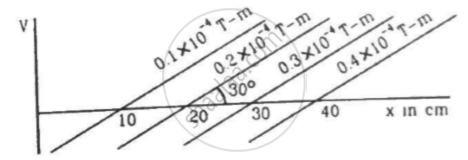Advertisements
Advertisements
Question
The magnetic field at a point, 10 cm away from a magnetic dipole, is found to be `2.0 xx 10^-4 "T"` . Find the magnetic moment of the dipole if the point is (a) in end-on position of the dipole and (b) in broadside-on position of the dipole.
Solution
Given:
Magnetic field strength, B = `2 xx 10^-4 "T"`
Distance of the point from the dipole, d = 10 cm = 0.1 m
(a) If the point is at the end-on position:
The magnetic field (B) on the axial point of the dipole is given by B = `u_0/(4pi) (2M)/d^3`
Here , M is the magnetic moment of the dipole that we need to find out .
`therefore` `2 xx 10^-4 = (10^-7 xx 2M)/(10^-1)^3`
⇒ `M = (2 xx 10^-4 xx 10^-3)/(10^-7 xx 2)`
⇒ `M = 1 A - "m"^2`
(b) If the point is at broadside-on position (equatorial position):
The magnetic field (B) is given by
B = `u_0/(4pi) M/d^3`
⇒ `2 xx 10^-4 = (10^-7 xx M)/(10^-1)^3`
⇒ `M = 2A - "m"^2`
APPEARS IN
RELATED QUESTIONS
State any two advantages of electromagnets over permanent magnets.
State how magnetic susceptibility is different for the three types of magnetic materials, i.e. diamagnetic, paramagnetic and ferromagnetic materials
State two advantages of an electromagnet over a permanent magnet.
Write two characteristics of a material used for making permanent magnets ?
Compare the direction of the magnetic field inside a solenoid with that of the field there if the solenoid is replaced by its equivalent combination of north pole and south pole.
The force on a north pole, `vecF = mvecB` , parallel to the field `vecB` . Does it contradict our earlier knowledge that a magnetic field can exert forces only perpendicular to itself?
A very long bar magnet is placed with its north pole coinciding with the centre of a circular loop carrying as electric current i. The magnetic field due to the magnet at a point on the periphery of the wire is B. The radius of the loop is a. The force on the wire is
Consider the situation of the previous problem. The directions of the magnetic field due to the dipole are opposite at
(a) P1 and P2
(b) Q1 and Q2
(c) P1 and Q1
(d) P2 and Q2
Figure shows some of the equipotential surfaces of the magnetic scalar potential. Find the magnetic field B at a point in the region.

The magnetic moment of the assumed dipole at the earth's centre is 8.0 × 1022 A m2. Calculate the magnetic field B at the geomagnetic poles of the earth. Radius of the earth is 6400 km.
The needle of a dip circle shows an apparent dip of 45° in a particular position and 53° when the circle is rotated through 90°. Find the true dip.
A moving-coil galvanometer has a 50-turn coil of size 2 cm × 2 cm. It is suspended between the magnetic poles producing a magnetic field of 0.5 T. Find the torque on the coil due to the magnetic field when a current of 20 mA passes through it.
A bar magnet takes π/10 second the complete one oscillation in an oscillation magnetometer. The moment of inertia of the magnet about the axis of rotation is 1.2 × 10−4 kg m2 and the earth's horizontal magnetic field is 30 μT. Find the magnetic moment of the magnet.
Choose the correct option:
Soft iron is used to make the core of the transformer because of its ______.
A steel wire of length 1 has a magnetic moment m it is then bent into a semicircular arc. The new magnetic moment is
Which magnetic properties are desirable for making a permanent magnet?
